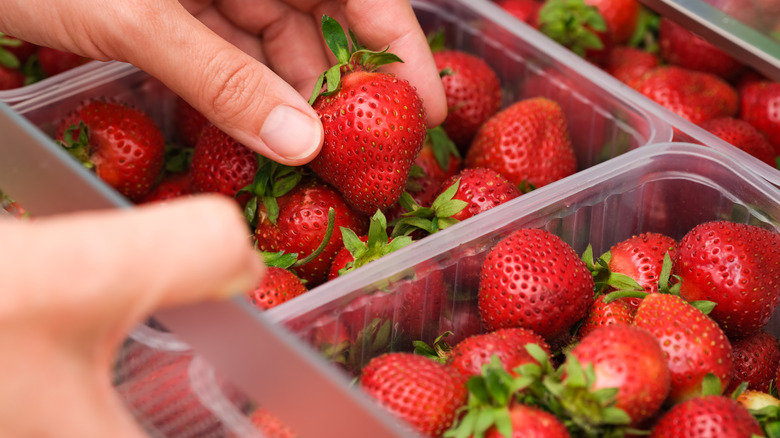Never Hull Fresh Strawberries Before Storing Them. Here's Why
Strawberries are delicious, delicate, and prized summer fruits that are as beloved as they are fleeting. The deterioration process is so swift that you may see moldy strawberries amongst the newly arrived cartons on grocery store shelves. While it's tempting to gobble down an entire carton of strawberries in one sitting, most of us would like to make this commodity last. But although there are plenty of suggestions for proper storage practices, storing hulled strawberries in the fridge is not one of them.
Hulling strawberries is an efficient method to remove the stem and leaves without sacrificing any of the edible flesh, which is the best practice for immediate consumption, baking them into strawberry cobbler, or making them into strawberry compote. However, placing hulled strawberries into the fridge for storage will cut their shelf life short because it dries them out and causes them to shrivel. Plus, strawberries are so delicate that you risk bruising them when you cut them, increasing the threat of exposure to mold. The only way to get away with storing hulled strawberries is to freeze them.
How do you store strawberries?
Hulling strawberries is just one of many no-nos when it comes to storing strawberries. The biggest catalyst for rotten strawberries is moisture because it aids the growth of mold and other bacteria. Bacteria spread quickly, so it's best to remove and discard strawberries with any mold on them before placing the carton in the fridge for storage.
Another bad idea for strawberry storage is air-tight containers; believe it or not, the holes in commercial plastic strawberry containers are deliberately engineered. Strawberries need good air circulation to stay dry.
Experts on food safety at the University of California's Division of Agriculture and Natural Resources claim strawberries last up to seven days in the fridge with proper storage practices. The easiest way to store fresh strawberries is to open up the carton, remove any moldy strawberries, then place them back in the fridge, unwashed. Sometimes less is more when it comes to strawberry storage, and this simple method consistently keeps strawberries fresh and mold-free for a week.
Another effective method to extend strawberries' shelf life requires washing them in a vinegar solution, patting them dry, then returning them to their carton. Vinegar inhibits mold spores from growing and proliferating. Various trials have shown that this method will keep strawberries fresh in the fridge for seven to 10 days. However, if you don't dry the strawberries sufficiently, they will get mushy, if not moldy.

